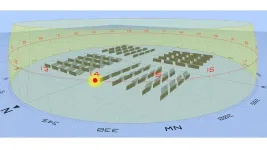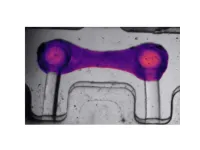(Press-News.org) A recent analysis shows that renewable energy could be a viable alternative to diesel fuel for science at the South Pole. The analysis deeply explores the feasibility of replacing part of the energy production at the South Pole with renewable sources.
For almost as long as humans have spent time in Antarctica, the continent has been a home for science. One of the research outposts located there is the Amundsen-Scott South Pole Station. The science done there includes studies of climate change and cosmology.
Currently, this site exclusively uses nonrenewable energy sources, specifically diesel fuel, to power the instruments and provide warmth for staff. A recent analysis by scientists at U.S. Department of Energy’s (DOE) Argonne National Laboratory and National Renewable Energy Laboratory (NREL) shows that renewable energy could be a viable alternative. Their analysis, published in Renewable and Sustainable Energy Reviews, explores the feasibility of replacing part of the energy production at the South Pole with renewable sources.
“All of the energy at the South Pole currently is generated by diesel fuel and a generator,” said Amy Bender, a physicist in Argonne’s High Energy Physics division. “We were asking if it is possible to transition to renewables. This study is the beginning of trying to make that case.” Bender, who has spent time working at the South Pole, is the paper’s corresponding author. The analysis illustrates the first steps for how renewable energy sources could be implemented at the South Pole, as well as details of what energy could be generated by these sources and the potential carbon savings that this program could enable.
To begin with, according to Ralph Muehleisen, chief building scientist and group manager for Buildings & Industrial Technologies at Argonne, the team wanted to know if using solar energy sources during the austral summer (November-February) would be feasible as a means of substantially reducing diesel fuel usage at the South Pole. “Just having diesel as a backup during the summer, you could reduce the carbon footprint,” says Muehleisen. “Even if we aren’t eliminating the use of diesel completely, being able to avoid having to buy that diesel fuel for the summer cuts back on its use significantly.”
“All of the energy at the South Pole currently is generated by diesel fuel and a generator. We were asking if it is possible to transition to renewables. This study is the beginning of trying to make that case.” — Amy Bender, Argonne High Energy Physics division
Sue Babinec, the program lead for stationary storage at Argonne, described the team’s focus on the type of energy storage required to make the project possible. She pointed out that renewable energy needs different energy storage than everyday battery applications such as transportation or consumer electronics. Demands specific to the South Pole make the differences even more stark. “The types of batteries that you need for power with renewable energy don’t just have to last for years, they have to provide energy for a very long period of time,” she said. “We did a detailed analysis of what type of battery works best depending on whether you’re using either solar or wind or both for power.”
“When I got into renewables, no one talked about deploying solar in Alaska or in Canada because it was very expensive and it’s not very sunny up there,” says Nate Blair, a group manager in the Integrated Applications Center at NREL. “A renewable component, paired with existing diesel generators, provides greater reliability and resilience. If one piece breaks, the other components in the system can help get you through until that can get repaired. We see continuing cost declines for solar and wind and batteries into the future.”
To complete their study, the team had to compile a substantial amount of data and then crunch the numbers to see the possibilities. Using NREL’s Renewable Energy Integration and Optimization software, they concluded that replacing 95% of the diesel fuel needed to supply 170 kW of power at the South Pole station would save approximately $57 million over 15 years, after an initial investment of $9.7 million. What’s more, the time before the investment would pay itself back through fuel cost savings would be just over two years. These results alone make it clear that the concept of replacing nonrenewable energy sources at the South Pole with renewable ones presents a worthy topic for further discussion.
Implementing any such plan will take considerable effort. That includes getting the equipment across the Southern Ocean, then across hundreds of kilometers of icy tundra to the South Pole. Also, the infrastructure would need to be built to make renewable energy use a reality. As Muehleisen puts it, “The DOE and universities all over the world have been trying to decarbonize our six continents. They’re only starting to reach Antarctica, so we are now truly, for the first time, talking about decarbonizing the world.” As he sees it, if we can begin to roll back use of nonrenewable energy sources at the last frontier on Earth, where only a few thousand people live and work at any one time, then there is no reason we can’t do it everywhere else.
In addition to Bender, Babinec, Blair and Muehleisen, the paper’s authors include Ian Baring-Gould, Xiangkun Li, Dan Olis and Silvana Ovaitt. The research was supported by the DOE.
Argonne National Laboratory seeks solutions to pressing national problems in science and technology. The nation’s first national laboratory, Argonne conducts leading-edge basic and applied scientific research in virtually every scientific discipline. Argonne researchers work closely with researchers from hundreds of companies, universities, and federal, state and municipal agencies to help them solve their specific problems, advance America’s scientific leadership and prepare the nation for a better future. With employees from more than 60 nations, Argonne is managed by UChicago Argonne, LLC for the U.S. Department of Energy’s Office of Science.
The U.S. Department of Energy’s Office of Science is the single largest supporter of basic research in the physical sciences in the United States and is working to address some of the most pressing challenges of our time. For more information, visit https://energy.gov/science.
END
New study shows renewable energy could work as power source at the Amundsen-Scott South Pole Station
Renewable energy could partially replace diesel fuel to power instruments and provide heat at the South Pole
2024-04-08
ELSE PRESS RELEASES FROM THIS DATE:
Cathie Biga is new American College of Cardiology president
2024-04-08
Cathie Biga, MSN, FACC, today became president of the American College of Cardiology and made history as the organization’s first non-physician president. She will serve a one-year term representing over 56,000 cardiovascular care team members around the world and leading the cardiovascular organization in its mission to transform cardiovascular care and improve heart health for all.
“I’m excited to bring my own set of leadership skills and perspectives to the ACC as we kick off the first year of our new Strategic Plan and celebrate the College’s 75th ...
Data shows medical marijuana use decreased in states where recreational use became legal
2024-04-08
Embargoed for release until 5:00 p.m. ET on Monday 8 April 2024
Annals of Internal Medicine Tip Sheet
@Annalsofim
Below please find summaries of new articles that will be published in the next issue of Annals of Internal Medicine. The summaries are not intended to substitute for the full articles as a source of information. This information is under strict embargo and by taking it into possession, media representatives are committing to the terms of the embargo not only on their own behalf, ...
Houston-area energy startup incubator wins phase 1 of DOE competition
2024-04-08
The U.S. Department of Energy’s Office of Technology Transitions (OTT) selected Texas Innovates, a non-profit organization focused on hydrogen and carbon innovation and expansion in the greater Houston and Gulf Coast region, as one of 23 phase 1 winners of the Energy Program for Innovation Clusters (EPIC) Round 3 competition. Notably, Texas Innovates is the only Texas entity to advance to phase 2 of the competition.
“We have been working towards this day since we identified the need for energy hardware incubation in 2017 and were a finalist in 2019 for C40 Cities global competition to make Houston’s Velasco Incinerator ...
A pulse of innovation: AI at the service of heart research
2024-04-08
A Pulse of Innovation: AI at the Service of Heart Research
Columbia biomedical engineers use AI to build a transformative new tool to study and diagnose heart function
Understanding heart function and disease, as well as testing new drugs for heart conditions, has long been a complex and time-consuming task. A promising way to study disease and test new drugs is to use cellular and engineered tissue models in a dish, but existing methods to study heart cell contraction and calcium handling require a good deal of manual work, are prone to errors, and need expensive specialized equipment. There clearly is a critical medical ...
Targeting vulnerability in B-cell development leads to novel drug combination for leukemia
2024-04-08
Despite having an overall survival rate of 94%, B-cell acute lymphoblastic leukemia (B-ALL), the most common childhood cancer, can prove challenging to treat, with survival among relapsed or resistant cases falling between 30-50%. Recent work by St. Jude Children’s Research Hospital scientists discovered which tumor cells resist treatment and why. This enabled the rational design of a combination therapy that better controlled high-risk subtypes of B-ALL in mouse models. The findings were published today in Cancer Cell.
“We found a new explanation of B-ALL ...
People make more patient decisions when shown the benefits first
2024-04-08
Key takeways
UCLA psychologists asked experiment participants to choose to receive $40 in seven days or $60 in 30 days, for example, under a variety of time constraints.
The experiment showed that people tend to make more impulsive decisions if they think about time delays first, and more patient decisions if they think about the greater reward associated with waiting longer.
The findings could be applied where people are being encouraged to make life choices that will benefit them in the long run, such as eating healthier, exercising or saving for retirement, by emphasizing the future large rewards and deemphasizing ...
New diagnostic tool achieves accuracy of PCR tests with faster and simpler nanopore system
2024-04-08
EMBARGOED UNTIL APRIL 8, 2024 AT 3:00 PM U.S. ET/ 12:00 PM PT
Over the past four years, many of us have become accustomed to a swab up the nose to test for COVID-19, using at-home rapid antigen tests or the more accurate clinic-provided PCR tests with a longer processing time. Now a new diagnostic tool developed by UC Santa Cruz Distinguished Professor of Electrical and Computer Engineering Holger Schmidt and his collaborators can test for SARS-CoV-2 and Zika virus with the same or better accuracy as high-precision PCR tests in a matter of hours.
In a new paper in the journal Proceedings of the National Academy of Sciences, Schmidt ...
Pregnancy accelerates biological aging in a healthy, young adult population
2024-04-08
Pregnancy may carry a cost, reports a new study from the Columbia University Mailman School of Public Health. The research, carried out among 1735 young people in the Philippines, shows that women who reported having been pregnant looked biologically older than women who had never been pregnant, and women who had been pregnant more often looked biologically older than those who reported fewer pregnancies. Notably, the number of pregnancies fathered was not associated with biological aging among same-aged cohort ...
Different means to the same end: How a worm protects its chromosomes
2024-04-08
University of Michigan researchers have discovered that a worm commonly used in the study of biology uses a set of proteins unlike those seen in other studied organisms to protect the ends of its DNA.
In mammals, shelterin is a complex of proteins that "shelters" the ends of our chromosomes from unraveling or fusing together. Keeping chromosomes from fusing together is an important job: chromosomes carry our body's DNA. If chromosome ends fuse, or if they fuse with other chromosomes, ...
ADA Forsyth scientists discover new phage resistance mechanism in phage-bacterial arms race
2024-04-08
One of the most abundant and deadliest organisms on earth is a virus called a bacteriophage (phage). These predators have lethal precision against their targets – not humans, but bacteria. Different phages have evolved to target different bacteria and play a critical role in microbial ecology. Recently, ADA Forsyth scientists exploring the complex interactions of microbes in the oral microbiome discovered a third player influencing the phage-bacterial arms race – ultrasmall bacterial parasites, called Saccharibacteria or TM7.
In the study, which appeared in Proceedings of the National Academy of Sciences ...
LAST 30 PRESS RELEASES:
Eye for trouble: Automated counting for chromosome issues under the microscope
The vast majority of US rivers lack any protections from human activities, new research finds
Ultrasound-responsive in situ antigen "nanocatchers" open a new paradigm for personalized tumor immunotherapy
Environmental “superbugs” in our rivers and soils: new one health review warns of growing antimicrobial resistance crisis
Triple threat in greenhouse farming: how heavy metals, microplastics, and antibiotic resistance genes unite to challenge sustainable food production
Earthworms turn manure into a powerful tool against antibiotic resistance
AI turns water into an early warning network for hidden biological pollutants
Hidden hotspots on “green” plastics: biodegradable and conventional plastics shape very different antibiotic resistance risks in river microbiomes
Engineered biochar enzyme system clears toxic phenolic acids and restores pepper seed germination in continuous cropping soils
Retail therapy fail? Online shopping linked to stress, says study
How well-meaning allies can increase stress for marginalized people
Commercially viable biomanufacturing: designer yeast turns sugar into lucrative chemical 3-HP
Control valve discovered in gut’s plumbing system
George Mason University leads phase 2 clinical trial for pill to help maintain weight loss after GLP-1s
Hop to it: research from Shedd Aquarium tracks conch movement to set new conservation guidance
Weight loss drugs and bariatric surgery improve the body’s fat ‘balance:’ study
The Age of Fishes began with mass death
TB harnesses part of immune defense system to cause infection
Important new source of oxidation in the atmosphere found
A tug-of-war explains a decades-old question about how bacteria swim
Strengthened immune defense against cancer
Engineering the development of the pancreas
The Journal of Nuclear Medicine ahead-of-print tip sheet: Jan. 9, 2026
Mount Sinai researchers help create largest immune cell atlas of bone marrow in multiple myeloma patients
Why it is so hard to get started on an unpleasant task: Scientists identify a “motivation brake”
Body composition changes after bariatric surgery or treatment with GLP-1 receptor agonists
Targeted regulation of abortion providers laws and pregnancies conceived through fertility treatment
Press registration is now open for the 2026 ACMG Annual Clinical Genetics Meeting
Understanding sex-based differences and the role of bone morphogenetic protein signaling in Alzheimer’s disease
Breakthrough in thin-film electrolytes pushes solid oxide fuel cells forward
[Press-News.org] New study shows renewable energy could work as power source at the Amundsen-Scott South Pole StationRenewable energy could partially replace diesel fuel to power instruments and provide heat at the South Pole







